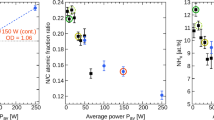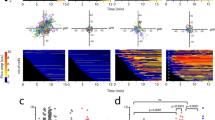Abstract
FROM physicochemical studies on the adhesion of fibroblasts to synthetic substrata1,2 I suggested that, in general, surface-bound polymers (for example adsorbed serum proteins) probably inhibit cell attachment because of their steric exclusion volume. This effect is well known in colloid science (Faraday used gelatin to stabilise gold sols3) but does not seem to be widely appreciated in cell biology. Thus, a recent review on the role of proteins and divalent cations in cell adhesion, viewed as a problem in colloid stability, discusses only charge repulsion and calcium bridging4. Furthermore, standard texts on the cell surface5 present the classical DLVO (Derjaguin, Landau, Verwey and Overbeek) theory of charge repulsion against dispersive attraction, but omit the later development by Overbeek and coworkers of the principle that even uncharged surfaces, if covered by adsorbed polymer molecules, may repel each other6. I now show that steric exclusion by glycocalyx polymers on the plasma membrane would explain some recent observations on fusion and attachment, by a variety of cells. The term steric exclusion3 comprises not only geometric exclusion by rigid molecules, such as rods and spheres, but also unfavourable thermodynamic parameters such as free energy, summed up over many segments, and, for random coil polymers, entropy resulting from the ability of each molecule to claim extra lebensraum by flexing its segments.
This is a preview of subscription content, access via your institution
Access options
Subscribe to this journal
Receive 51 print issues and online access
$199.00 per year
only $3.90 per issue
Buy this article
- Purchase on Springer Link
- Instant access to full article PDF
Prices may be subject to local taxes which are calculated during checkout
Similar content being viewed by others
References
Maroudas, N. G., Nature, 244, 353 (1973).
Maroudas, N. G., J. theor. Biol., 49, 417 (1975).
Vincent, B., Adv. Colloid Interface Sci., 4, 193 (1974).
Okada, T. S., Takeichi, M., Yasuda, K., and Ueda, M. J., Adv. Biophys., 6, 157 (1974).
Curtis, A. S. G., The Cell Surface (Academic, London and New York, 1967).
Hesselink, F. T., Vrij, A., and Overbeek, J. T. G., J. phys. Chem., 75, 2094 (1971).
Ahkong, Q. F., Fisher, D., Tampion, W., and Lucy, J. A., Nature, 253, 195 (1975).
Glasstone, S., Textbook of Physical Chemistry, 1253–1255 (Macmillan, London, 1956).
Tanford, C., Physical Chemistry of Macromolecules, 197–201 (Wiley, New York, 1961).
Maciero-Coelho, A., Berumen, L., and Avrameas, S., J. cell. Phys., 83, 379 (1974).
Gordon, J. L., and Dingle, J. T., J. cell. Sci., 16, 157 (1975).
Lyman, D. J., Angew. Chem. int. Ed. Engl., 13, 108 (1974).
Rabinovitch, M., and De Stefano, M. J., J. Cell Biol., 59, 165 (1973).
Balsamo, J., and Lilien, J., Nature, 251, 523 (1975).
Abercrombie, M., Heaysman, J. A. M., and Pegrum, S. P., Expl. Cell Res., 67, 359 (1971).
Author information
Authors and Affiliations
Rights and permissions
About this article
Cite this article
MAROUDAS, N. Polymer exclusion, cell adhesion and membrane fusion. Nature 254, 695–696 (1975). https://doi.org/10.1038/254695a0
Received:
Accepted:
Issue Date:
DOI: https://doi.org/10.1038/254695a0
This article is cited by
-
Surface-Carboxylated Nanocellulose-Based Bioadaptive Scaffolds for Cell Culture
Cellulose (2022)
-
A versatile click-grafting approach to surface modification of silk fibroin films
Journal of Materials Science (2013)
-
Directing cell motions on micropatterned ratchets
Nature Physics (2009)
-
The role of bacterial surface and substratum hydrophobicity in adhesion ofLeptospira biflexa serovarpatoc 1 to inert surfaces
Microbial Ecology (1986)
-
The production and release of an extracellular polysaccharide during starvation of a marine Pseudomonas sp. and the effect thereof on adhesion
Archives of Microbiology (1986)
Comments
By submitting a comment you agree to abide by our Terms and Community Guidelines. If you find something abusive or that does not comply with our terms or guidelines please flag it as inappropriate.



